Program Profile: Urban Sustainability
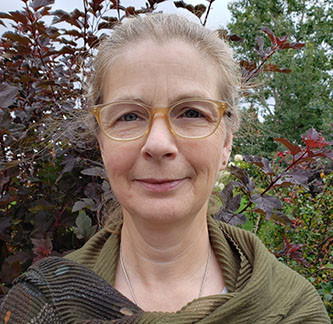
Associate Professor Rebecca Boger, Director of the Urban Sustainability Program.
One of the most forward-facing programs that Brooklyn College offers is the interdisciplinary urban sustainability (SUST) major. The mission of the program is to provide knowledge and skills that can help students develop environmental practices that will better their communities in the face of a climate crisis and related environmental challenges. The program was designed by a team of professors including Brett Branco, Ken Gould, Becky Boger, Tammy Lewis, Yehuda Klein, and Mike Menser in 2012 and has been growing since then.
SUST offers concentrations in economics, environmental science, and sociology, and is truly interdisciplinary with faculty from three different schools—the Koppelman School of Business, the School of Natural and Behavioral Sciences (NBS), and the School of Humanities and Social Sciences (HSS), tapping such departments as Philosophy, Sociology, Economics, Biology, and Earth and Environmental Studies. The core courses of the program are team-taught and represent the three "pillars" of sustainability: equity, economics, and environment. Both the introductory and theory courses are co-taught with one instructor from NBS, one from Koppelman, and one from HSS. The current program director, Associate Professor Rebecca Boger, of the Department of Earth and Environmental Studies, has helmed the program since 2019 and has taught in the program since its inception. Boger was quick to remark that "the strength of the program is our students and faculty and its interdisciplinarity across schools."
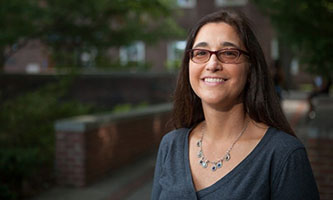
Professor Tammy Lewis
The program takes a unique interdisciplinary approach, offering students three different concentrations under the urban sustainability umbrella—environmental science, environmental economics and business management, and environmental sociology. The program is in the process of launching an M.A. in urban sustainability as well.
One of the key goals of the program is to use the Brooklyn community for place-based research. And clearly, using Brooklyn’s location is an advantage because there is no better way to learn about urban sustainability than by developing solutions in your own backyard. Thus, one of the key learning strategies and attractions of the program is its hands-on approach to studying these problems. The program offers field trips to community gardens, local beaches and waterways, public transportation facilities, and city parks, different environments where sustainability efforts may be starting or where they may be needed. Another focus of the program is its emphasis on student research, often in conjunction with a faculty member. By emphasizing student research, even at the undergraduate level, students are laying the groundwork for successful careers in this area. The program builds in hands-on experience via internships and sustainability projects to teach students how to problem solve and directly apply their academic knowledge.
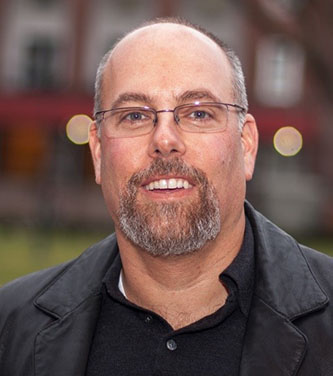
Professor Ken Gould
Indeed, as Boger noted, "Students are the strongest part of the program. They continue to amaze me with their creativity, intelligence, and commitment to examine and solve real-world problems in order to make our world better, more sustainable, and more resilient."
One of the program's recent alumni, Adam Guzman, has taken what he learned in the program to work toward building a career that can be both impactful and personally rewarding. He attended the Williamsburg Charter School and is the first in his family to graduate from college. He recognizes Boger for helping him overcome his anxieties regarding striving for success in college, and happily reported that the capstone course he took in spring 2020 was "great!" He credits the program with helping shape his strong views on "translational science," a concept in which he firmly believes and which asserts that the community must be involved in and understand the science that impacts their lives. He is certain that the lack of dynamic and collaborative communication in all levels of governance, with communities on the local level "further exacerbates the lack of care and or proactive action required to protect those most vulnerable to climate change. The most vulnerable being BIPOC and non-BIPOC who have historically borne the brunt of most of our nation's environmental violence and crimes."
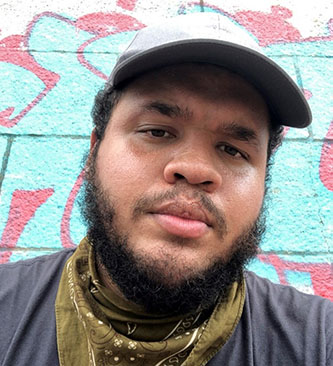
SUST program alumnus Adam Guzman
Though he was not able to snag an internship while in the program, he joined one right after graduation with the Natural Areas Conservancy. He then briefly worked with the Earth Institute at Columbia and recently returned to participate in the early fall and winter data collection portion of their pilot study. This Earth Institute study aims to investigate the relationships between "greenspace attributes, place attachment, and social wellbeing." When he started as a research assistant, he helped with the development and execution of the pilot study's initial protocols and data collection efforts. He very eloquently stated his outlook on the relationship between sustainability and community well-being thusly: "I believe that actively fostering one's environmental citizenship has the power to mend the divide that exists between what culturally we perceive as wilderness and what we perceive as urban space. It is not only necessary for a city to co-exist and thrive alongside its natural areas; it is an obligation that a city has to its citizens (human and nonhuman) to ensure the health of all." His future goal is to gain a long-term position in his field, and he is aiming for full-time work in the environmentally focused social impact sector, environmental monitoring and assessment, or environmental education.
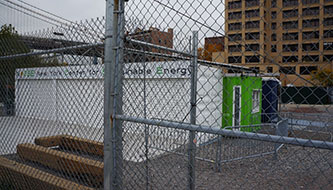
The Electric Vehicle (EV) charging station at Brooklyn Bridge Park, seen during a pod walk.
In general, student projects reflect the program’s interdisciplinarity. For example, an area of student research that crosses disciplinary areas such as economics, public policy, medicine, sociology, and issues of racial justice is e-commerce and how that affects New York City. The students who worked on the e-commerce project were able to show how environmental impacts in certain communities affected various socioeconomic groups more than others as well as give examples of how large corporations were pushed to have "greener" options because of the social push for more sustainable programs. One of the areas highly impacted by e-commerce is trucking and transportation, which is accompanied by a mass amount of air pollution. Of course, truck pollution affects the respiratory system, and in neighborhoods such as Mott Haven in the South Bronx where many Black and Latin people live, residents experience unequal adverse health outcomes as a result of air pollution. The student researchers in the e-commerce project wrote that sustainability legislation to ameliorate this disparity are being proposed and noted that a New York City state assembly member proposed a $3 Amazon tax to funnel money into the local economy as well as improve the MTA.
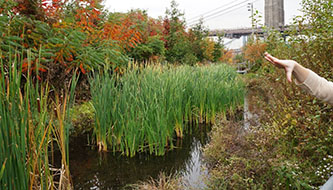
Lush green space in the shadow of the bridge at Brooklyn Bridge Park, seen during a pod walk.
The Urban Sustainability program is known for developing pod walks, one of the hands-on learning techniques used in the program. Ultimately acting as a learning tool for the students and potentially the public, these interactive walking tours guide participants through the various aspects of a site and help them understand and navigate its sustainability efforts. Each pod walk consists of an audio guide detailing sustainability at each stop, a visual map of the stops, and an interactive guide highlighting the main points at each stop and tips to engage with the site. The pod walks began in 2012 under the supervision of Professor Lewis, where Macaulay Honors students started pod walks in order to focus on the environmental, social, and economic aspects of urban sustainability within their own communities. Boger further developed pod walks in 2018 for the SUST capstone course.
The pod walks are posted on the SUST website and offer a visual way to learn how urban sustainability works within our own backyard, showing a well-rounded view of how pollution, recycling, and industry are affecting local communities both economically and socially.
The program expects to keep growing as it prepares students for both research and practical applications in growing fields that respond to the challenges of climate change. Growth areas such as recycling, wind and power industries, resource management, environmental public policy and advocacy, and city environmental coordination can be expected to employ students for many years to come.






